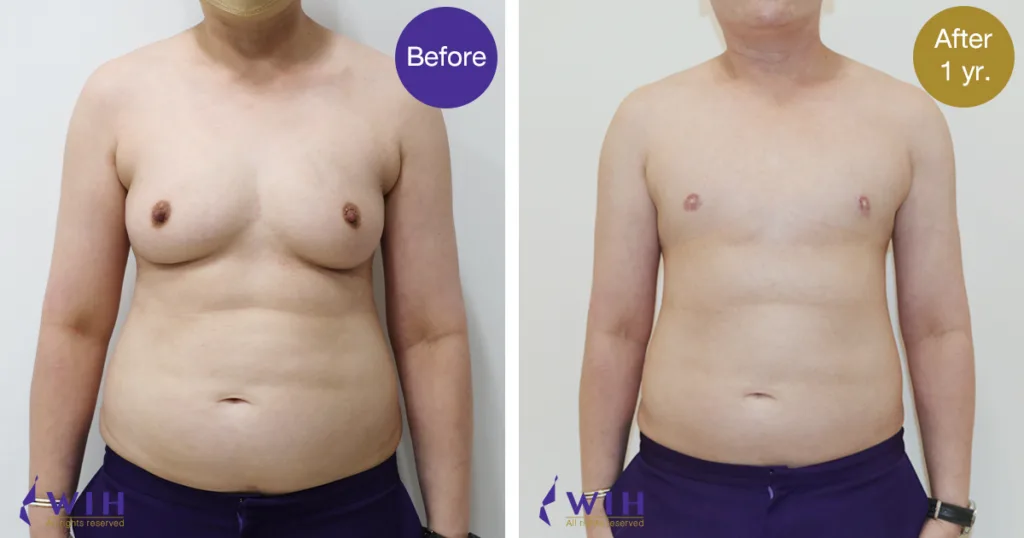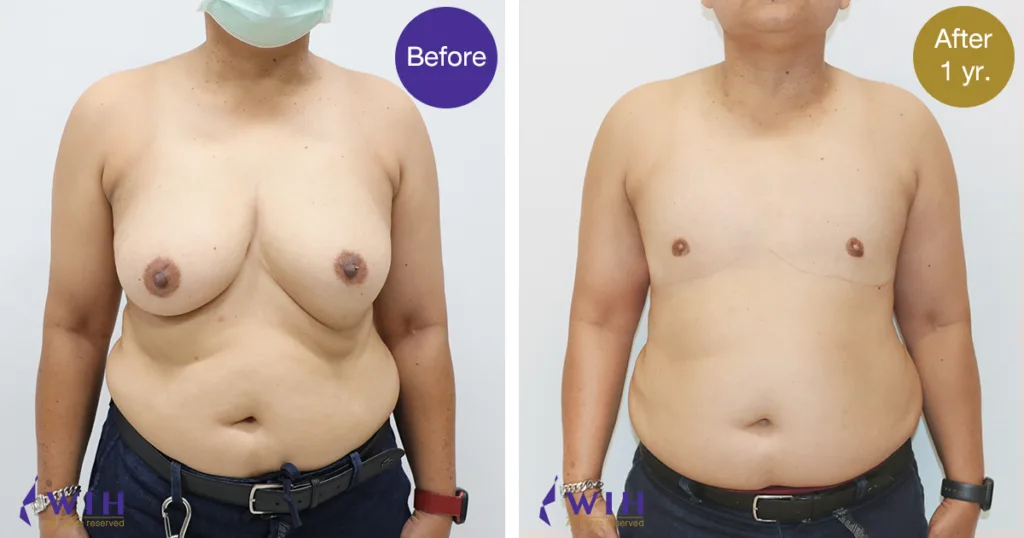Understanding Mastectomy (Top Surgery)
Gender-affirming Mastectomy (Top Surgery) is a surgical procedure that involves the removal of breast tissue (subcutaneous mastectomy) and the reconstruction of the chest to create a masculine or a more androgynous or neutral shape for some non-binary individuals. This procedure is a crucial step for many transgender men (FTM) and non-binary people seeking to alleviate gender dysphoria and live more authentically.
Mastectomy (Top Surgery) Techniques at WIH Hospital
Achieving the optimal outcome in Mastectomy (Top Surgery) requires a careful selection of surgical techniques tailored to your unique anatomy, chest size, skin elasticity, and aesthetic goals. At WIH Hospital, our experienced board-certified surgeons are proficient in advanced techniques to create a natural-looking masculine chest.
Common Mastectomy (Top Surgery) Techniques:
Periareolar Mastectomy
- This technique is suitable for individuals with small to moderate amounts of breast tissue, good skin elasticity, and those who prioritize nipple sensation and wish to avoid long horizontal scars.
- The scar will be around the border of the areola, allowing for the removal of breast tissue.
- Generally, there is a higher likelihood of preserving nipple sensation.
Double Incision Mastectomy (with Nipple Grafts)
- This is the most common technique, particularly for individuals with moderate to large amounts of breast tissue or significant skin laxity.
- It involves two horizontal or slightly curved incisions made across the chest, typically along the lower border of the pectoral muscle, to remove breast tissue and excess skin.
- Nipple sensation may be reduced or absent initially, with some potential.
A Good Candidate for Mastectomy (Top Surgery)
Our approach aligns with international standards of care, such as those outlined by the World Professional Association for Transgender Health (WPATH).
- Transmen
- Stable mental health
- Age over 18 years
- Reasonably Good Physical Health
- Have realistic expectations
Comprehensive Personalized Consultation and Preparing for Mastectomy (Top Surgery) at WIH Hospital
- You will have a confidential discussion in a comfortable environment. The surgeon will listen carefully to understand your desired chest appearance.
- Your surgeon will perform a respectful examination of your chest to assess the size and shape of your breasts. Evaluating your skin quality, elasticity, and measuring chest dimensions.
- The surgeon will discuss your hormone status and any implications for surgery. It’s generally recommended to have stable hormone levels.
- The patients must stop smoking (including nicotine products and vaping) for a significant period before surgery.
- Avoid alcoholic beverages for at least one week before surgery.
- For the excessively high Body Mass Index (BMI) patients, the surgeon may recommend weight management before surgery.
- Mastectomy (Top Surgery) is typically performed under general anesthesia.
Recovery after FTM Mastectomy (Top Surgery)
- Avoid raising your arms above shoulder level for the first few weeks.
- Expect moderate to significant swelling and bruising across the chest and potentially extending to the abdomen. This is normal.
- Do not lift anything heavy for the first 4-6 weeks.
- Showering may be permitted depending on drain removal and the surgeon’s instructions.
- Most individuals can return to non-strenuous work or daily routines after 2- 4 weeks.
- Can see the final result after the surgery, 6 months, and 1 year.
⏱️ Surgery & Recovery Timeline
-
Surgery Duration: 2–3 hours
-
Hospital Stay: 1–2 nights
-
Full Recovery: 4–6 weeks
-
Back to Work: Most patients resume light activities in 2–3 weeks
Our team provides detailed aftercare instructions and is available to support you through your healing process.
Potential Risks
- Bleeding (Hematoma)
- Infection
- Seroma
- Poor wound healing
- Pain
Benefits
- Achieving a chest appearance that aligns with one’s true gender identity.
- Improvements in mental health
- More comfortable and confident
- Ability to wear a wider range of clothing without concerns about chest appearance or binding.
- Social and Physical Comfort
💬 Patient Testimonial
“The surgery at WIH gave me not only a flat chest, but also confidence. The staff were professional and deeply respectful. I finally feel like myself.”
— K., Trans man and patient at WIH Hospital
If you would like to view more results of Adam’s apple reduction, you can go to click
Potential Risks and Side Effects
Post-Surgical Bleeding
- Due to the vascular nature of breast tissue, bleeding may occur, necessitating drainage to prevent hematoma formation.
Swelling and Pain
- Some swelling and discomfort are common but manageable with pain relief medications.
Infection Risk
- Infection is rare but can occur.
Tissue Necrosis
- Insufficient blood supply may lead to necrosis in nipple or breast tissue.
Scarring
- Scarring is possible, and sensation changes, including numbness, may occur.
Anesthesia Risks
- All surgical procedures carry risks associated with anesthesia.
FAQ
WIH Hospital generally follows international standards of care, such as those from WPATH. This often includes requiring a letter from a qualified mental health professional diagnosing gender dysphoria and confirming your capacity for informed consent. Specific requirements will be discussed during your consultation.
The duration of the surgery typically ranges from 2 to 5 hours, depending on the complexity of the case and the specific techniques used.
Initial recovery is about 1-2 weeks. Most people can return to light activities and desk work within 2-3 weeks. Strenuous activities and heavy lifting should be avoided for 4-6 weeks, or as advised by the surgeon.
While many transgender men are on testosterone, it is not always a strict requirement for all individuals seeking top surgery, particularly for some non-binary people.
Absolutely. WIH Hospital surgeons understand that non-binary individuals may have unique goals for their chest appearance, which may not be a traditionally masculine flat chest. We encourage open discussion about your desired outcome, and surgical plans can often be customized.






